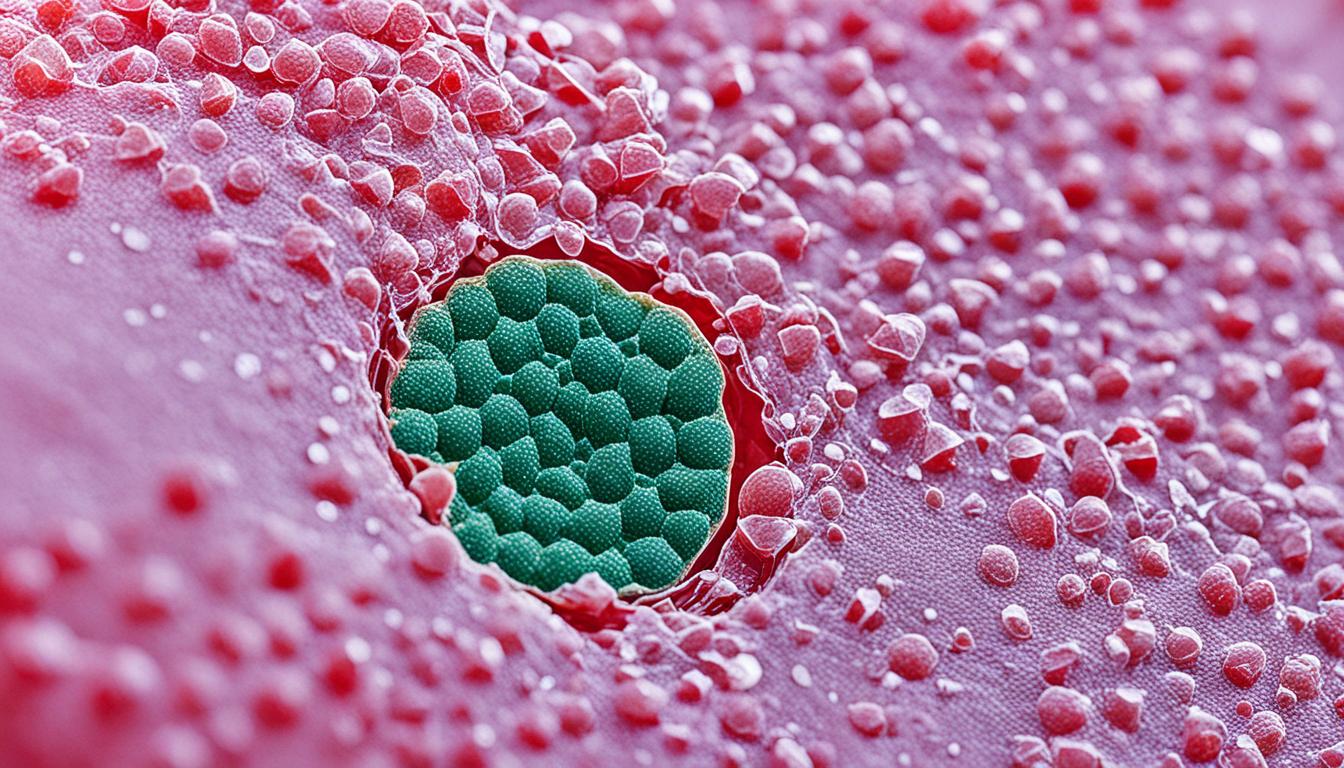Common warts are a skin issue many people face. These small bumps look like grains and appear on fingers or hands. The human papillomavirus (HPV) causes them and you can get them from touching someone’s wart. The virus enters the body through skin breaks.
Common warts have some signs that make them easy to spot. They feel rough and might have small black dots, which are blood vessels. Although these warts are not harmful, they can be taken out if they bother you. Or, if you find them embarrassing.
Key Takeaways:
- Common warts are small, grainy bumps that commonly appear on the fingers or hands.
- They are caused by the human papillomavirus (HPV) and are transmitted through direct contact.
- Common wart symptoms include fleshy, grainy bumps on the fingers or hands that feel rough.
- While common warts are usually harmless and go away on their own, some people choose to remove them.
- Common warts can be diagnosed through visual examination or a small biopsy.
Causes and Risk Factors of Common Warts
Common warts come from the human papillomavirus (HPV). They are mainly on the hands and fingers. You can get warts through skin-to-skin contact or touching infected items. The virus enters your body through cuts or scratches.
Over 100 types of HPV exist. But, only a few lead to hand warts. Remember, not everyone catches warts from HPV. Each person’s immune system reacts differently. Certain things can make you more likely to get common warts.
HPV Transmission
HPV spreads in several ways, like:
- Touching an infected person’s skin
- Sharing items like towels or nail clippers
- Contact with virus-contaminated surfaces
To lower your risk, keep skin clean and avoid touching warts directly.
Weak Immune System and Warts
A weak immune system raises your risk for warts. When your immune system is weak, it can’t fight the virus as well. Things that lower your immunity include:
- Existing health conditions
- Medicines that lower immunity
- Stress
- Bad eating habits
If your immune system is weak, try to avoid HPV. Stay healthy to prevent warts.
Also, certain actions like biting nails or picking at hangnails can up your wart risk. They open the skin, giving the virus an easy way in.
Diagnosis and Treatment of Common Warts
Healthcare pros can spot common warts just by looking. They closely check the skin for small, rough bumps. Sometimes, they need to do more tests to be sure.
They might scrape off a bit of the wart to look for dark spots. These spots show up if the wart has blood vessels inside. This can help tell common warts apart from other skin issues. How they treat the warts depends on how bad they are and where they are.
Over-the-counter wart treatments can work well. They use salicylic acid to break down the wart. You put the acid on the wart, and it peels away over time. Make sure to follow the instructions and not use it on sensitive skin.
Another choice is cryotherapy, where they freeze the wart. This is done with liquid nitrogen or a similar cold agent. The cold kills the wart, and it eventually falls off. A pro or you can do this with special at-home products.
For tough warts, doctors might use acids or do surgery to remove them. They might also use a CO2 laser to zap the wart. This helps get rid of it and keeps it from coming back.
Home remedies like salicylic acid or freezing kits can help. But, it’s smart to talk to a doctor first. They can recommend the best treatment for you. This way, you’ll get rid of the wart safely and quickly.
Conclusion
Common warts, caused by the human papillomavirus (HPV), are a common skin problem. Although they are usually not dangerous, they might make you feel uncomfortable. Luckily, many treatments can help.
Over-the-counter products with salicylic acid can be a good first step. Professional treatments like cryotherapy or laser ablation are also options. DIY methods with salicylic acid might work to treat warts at home.
To stop common warts, taking the right steps is key. Avoid touching warts directly, keep your hands clean, and stay healthy. These things can help prevent warts from spreading.
If you’re worried about warts or considering treatment, it’s smart to talk to a doctor. They can check you and give you advice tailored to your needs. This is the best way to get the right care.
By knowing more about warts, trying home treatments, and preventing them, you can handle warts better. Always be proactive about your skin health and get professional advice when needed.

